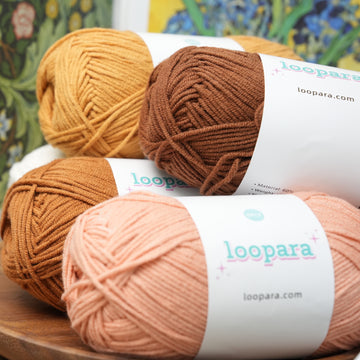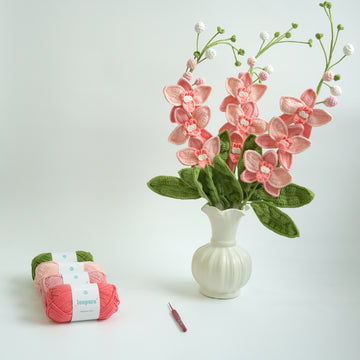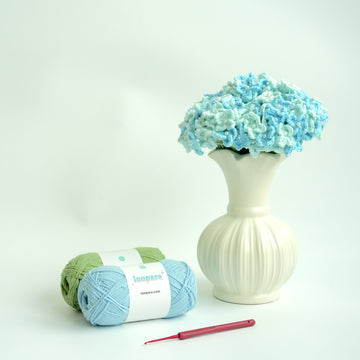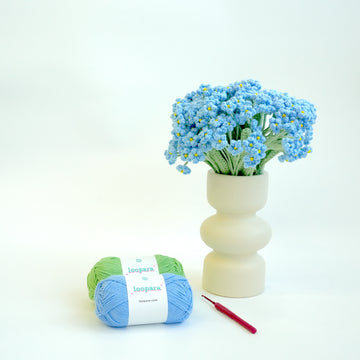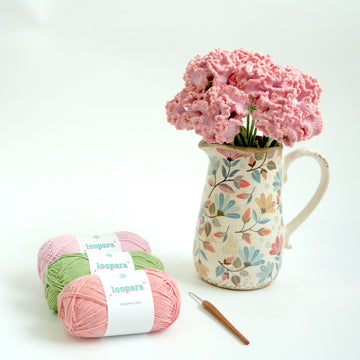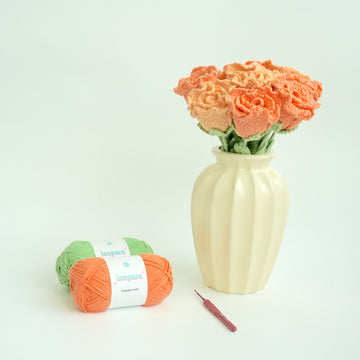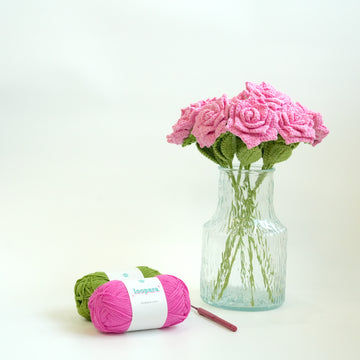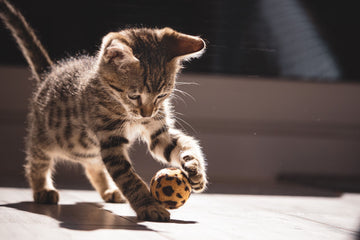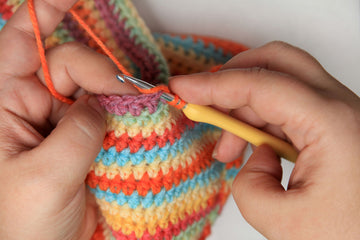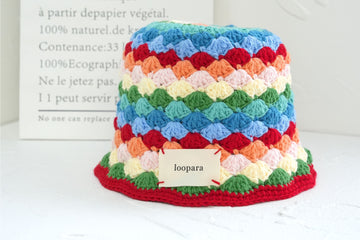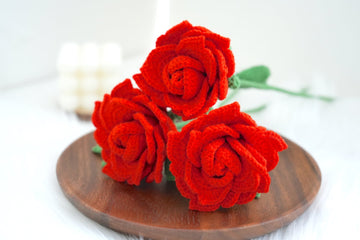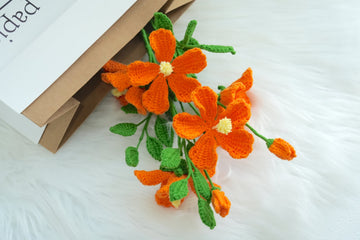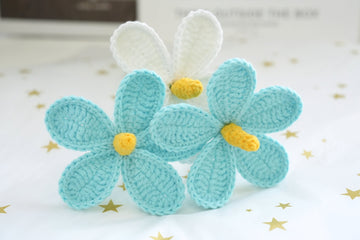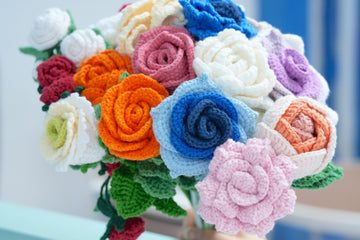Have you found the perfect crochet pattern – but it’s not in the perfect size? We’re going to explore how to make a crochet pattern bigger.
How you do this will depend on what you’re making. We’ll look at how to go about enlarging a pattern for a scarf, a blanket and amigurumi.
Ready? Then let’s get started!
Why different techniques are used to make crochet patterns bigger
The first thing to bear in mind when you’re making a crochet pattern bigger is that different types of articles need different approaches.
Some types of crochet – amigurumi, for example – are designed to create three dimensional objects. But if you’re making a blanket, it’s two dimensional. And while scarves are two dimensional too, most people wanting to make a scarf bigger will really mean making it longer.
Depending on what you’re making, then, to make it “bigger” you might need to:
- make it longer (for example, a scarf)
- make it longer and wider (a blanket), or
- make it longer, wider and deeper (amigurumi).
1. Crocheting a scarf: How to make a pattern longer

Let’s start with the simplest option – making a pattern bigger in one dimension. The obvious example of where you would do this is when you’re making a scarf. If you want something you can wrap around your neck multiple times, you may need to make it longer.
The good news is, this is pretty easy to do. All you need to do is add in extra rows of stitches. But how many extra rows do you need?
A good way to determine this is to make up a gauge swatch from your pattern. That will show you how your yarn, hook and stitches combine to make the fabric.
Gauge swatches are usually at least 4 inches by 4 inches. That’s enough for any inconsistencies in the tension to average themselves out.
Measuring the gauge swatch will show you whether the number of stitches and rows specified in the pattern is giving you the right sized piece of fabric. If your tension is too tight, the fabric will be smaller than it should be according to the pattern, If it’s too loose, the fabric will be bigger.
You can make as many gauge swatches as you like until you’re happy with the results. Then take a ruler and count the number of rows that make up a section of the fabric – say, 4 inches.
Now divide the length you want your scarf to be by the length of that section. Multiply the answer by the number of rows in that section to give you the total number of rows you’ll need to make.
For example:
Your gauge swatch tells you there are 8 rows per 4-inch length of fabric. You want your scarf to be 5 feet long.
5 feet = 60 inches.
60 /4 = 15
15 x 8 = 120 rows
If your pattern is very simple, this is all you’ll need to do. But if it uses different stitches, you may need to adjust the number of rows to take account of the pattern repeat.
2. Crocheting a blanket: How to make a pattern longer and wider

If you’re crocheting a blanket, you’ll need to consider both its length and width to make it larger. If you want to keep the shape the same as the original pattern, whatever multiple you apply to one dimension, you’ll need to apply to the other too.
It’s worth noting that if you apply a multiple to both the length and width of a blanket, you’ll be multiplying the blanket’s surface area by a larger number. A simple example will show how this works.
Say you have a pattern for a blanket that’s 1 foot wide by 1 foot long. That gives it a surface area of 1 x 1 = 1 square foot. (Yes, we know that’s a small blanket! But bear with us, because it will be easier to see what we mean with easy numbers.)
You decide you want to double the length. And you still want your blanket to be square, so you’re going to double the width too.
That means your new blanket will be 2 feet wide by 2 feet long. That gives it a surface area of 2 x 2 = 4 square feet. In other words, the surface area will be four times the size of the original. And it will require four times as much yarn.
Instead, you want your square to have only twice the surface area of the original – 2 square feet.
One way to achieve that would be to double the length of the blanket and keep the width the same. That would simply mean doubling the number of rows in the original pattern.
That would give you a blanket 2 feet long and a foot wide. The surface area would be 2 x1 = 2 square feet.
If you wanted your blanket to still be a square though, you would need to find the square root of 2. That will give you the length and width of the blanket.
The easiest way to find a square root when it isn’t a whole number is to use a calculator. That tells us that the square root of 2 is 1.4 (plus a whole lot of decimal points). So each side of the blanket would need to be 1.4 feet long, or 1 foot 5 inches (rounding to the nearest inch).
Once you’ve chosen the length and width of your blanket, you can get to work making a gauge swatch. That will allow you to check how many stitches are needed to get to the required width, and how many rows for the required length.
Making a crochet blanket bigger without the math
If all the maths here sounds like hard work, don’t worry! There are simpler ways of using an existing pattern to make a blanket bigger.
- Make a blanket from granny squares. If you have a pattern that uses granny squares, a simple way to make your blanket bigger is to make more squares. Just make as many as you want, then stitch them on to widen or lengthen the blanket. Because each granny square will be the same, you can use the same pattern for each one.
- Use a larger hook and thicker yarn. Scaling up your hook and yarn will automatically give you a bigger blanket, even with exactly the same pattern. The easiest approach here is to experiment with a gauge swatch so you can see how much bigger your scaled up blanket will be than the original.
If the results aren’t big enough, simply swap again for a thicker yarn and bigger hook. (Alternatively, you could use two strands of your yarn instead of one.) Or if you find it’s got too big, swap for a thinner yarn and smaller hook.
3. Crocheting amigurumi: Making a pattern longer, wider and deeper

There’s no denying that scaling up patterns in three dimensions, as you need to for amigurumi, is a more complicated prospect.
One way to do it is simply to use a thicker yarn and hook. Alternatively, you could use two strands of a thinner yarn. Just remember that you’ll need at least twice as much of the yarn if you take that route.
But you might also find that you need to adjust the pattern as you go. That’s because, even if you scale up every measurement by the same factor, the proportions may look wrong. You might find your head ends up a funny shape or the tail is too short.
It’s all part of the joy of working in three dimensions!
The key here is to check the fabric regularly and be prepared to make changes. You might find you need to add extra stitches or rows to make everything look right. Be prepared for plenty of frogging!
It’s a good idea to make a note of the changes you make as you go along. That way you’ll avoid having to repeat the same process of trial and error if you want to make the same sized toy again.
How to make a crochet pattern bigger: a quickfire summary
The process for making a crochet pattern bigger depends on what type of article you’re making. If you want to make a simple pattern longer, you’ll just need to add more rows. That will work well for something like a scarf.
If you want to increase both the length and width, you can increase the size of your hook and yarn. Use a gauge swatch to work out how much bigger the finished article will be than the dimensions in the pattern.
If you want to be more precise, scale up the measurements for length and width, and use a gauge swatch to calculate stitches and rows. Just remember that doubling both the length and width will give you an item that’s four times the size of the original.
The more complicated the pattern, the more you might need to make adjustments like adding in extra stitches or rows.
And that’s particularly the case if you’re working in three dimensions, as with amigurumi. Be prepared to adjust the pattern regularly to make sure the proportions work.


